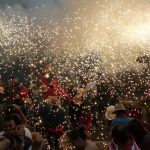Barcelona Attractions
The Gaudí Tour all over Barcelona
Barcelona city wouldn’t be the same without the work of Gaudí. The route through the Gaudi’s emblematic buildings is a must for everyone coming to visit Barcelona. Even the most famous constructions, like the Sagrada Familia or the Batlló House, or either the most unknown buildings, like the Teresianas College or the Bellesguard Tower, will not leave indifferent those who approach their beauty.
House and Park Güell Tour
We start the tour from the Park Güell, a huge garden with really peculiar architectural components. Although the original project was to build a residential quarter, this idea was soon abandoned and a park of the dignity of a fairy tale scenario was built instead. You can’t abandon the park without climbing the monument to Calvary to get the best views of the city, take some rest in the bench of 110 meters that looks like a snake in the centre of the park and pass by the Gaudi House Museum or try to take a picture in the fountain of the dragon.
We continue the route to the pavilions of the entrance of the Güell House, the first partnership between Gaudí and the Barcelonan businessman, where the three secondary gatehouses and the main entrance are still preserved, flanked by a pavilion on the door and stables.
The unknown Gaudí
From Pedralbes we go up to Sant Gervasi to go to the Bellesguard Tower, one of the most unknown but most peculiar and full of symbolism buildings made by the Catalonian architect. In this building he could construct in absolute freedom, taking in count only one limit: to respect the ruins of the old medieval castle.
Without leaving Sant Gervasi, the route brings us to the Teresianas College, a project where Gaudí had to respect the limited economic power and the austerity of the congregation. Given this, and having to respect the base already constructed, the architect could figure the college as a peculiar neo gothic castle, incorporating many religious symbols to the façade. In the interiors you can admire the obsession of Gaudí to get the best of the natural light, constructing in it several atriums in the upper floors as well as in the main hall.
The next stop will show us another of the less known works of Gaudí. The Vicens House is the first important project of the architect after his degree in 1878 where we can admire a clear influence of the Middle East art, as well as the mudéjar and nazarí art.
Sagrada Familia Tour
After the visit of the most unknown work of Gaudí, we stop in the building that probably has turned to be the most famous and characteristic symbol of Barcelona: Sagrada Familia. The construction started in 1882 in a neo gothic style, but one year later the project passed to Gaudí’s hands, who replanted it completely. Gaudí designed an exceptional and innovative temple that was going to be composed by 18 towers, but he had the time to create only few of them before his death.
Gaudí died in 1926 leaving unfinished the project that fulfilled his last years of life, but, thanks to the preserved plans, the work is continuing and will probably finished by 2026.
The end of Gaudí Tour
We continue through the Eixample with the two great proposals of Gaudí for civil buildings. First, we pass by the Milà House, the famous Pedrera, with waving shapes that remembers of the waves of the sea. A little further, the Batlló House, a metaphor of the legend of Saint George. And without abandoning the format, but changing neighbour, we can finish the route in the Palau Güell, that allows us to delve into the architectonic solutions conceived by Gaudí to give comfort to one of the most important bourgeois families of the city.
But this is not the end. To finish the day dedicated to Gaudí, we propose a dinner in the Calvet House, a restaurant in the house of the same name, work of Gaudí and rewarded as the best building of the city in 1900, as well as few drinks in the several terraces of the Reial Square, where you can admire the lamp posts designed by the master of the art nouveau style.




